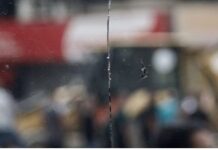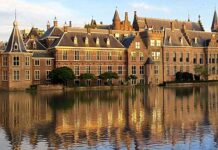Meron Rapoport & Oren Ziv
+972 Magazine / July 2, 2023
Ronen Bar, the head of Israel’s domestic intelligence, spread disinformation in order to portray Palestinians as terrorists and Jews as innocents.
Mainstream Israeli society often views the Shin Bet as the responsible adult in the room — a body that towers above the petty squabbling of politicians, and that is entrusted with protecting citizens from security threats. But listening to the disinformation uttered by Shin Bet head Ronen Bar last week, one gets the sense that his department, like most of the Israeli government, is not immune to the temptations of spreading propaganda.
Speaking to an audience of thousands last Tuesday during Tel Aviv University’s Cyber Week, an annual international cybersecurity conference, Bar discussed the digital threats facing Israel — and devoted a significant portion of his speech, delivered in English, to “fake news” on social networks.
In particular, Bar offered several mistruths about May 2021 and the events leading up to the violence that swept the country at the time; that period was, he said, an exemplary case of misinformation, when “the combination of the simplicity in creating fake reality, together with mass distribution on social media, pushed us to the brink of a war.”
To make his case, Bar screened a video produced by the Shin Bet that was meant to set the record straight on what sparked the violence, and to propose how Israel can better prepare for fake news spread by Palestinians “terrorists.”
According to the video’s narrator, the violence began in earnest on May 10, 2021, after Palestinians on social media shared a now-infamous clip of Israeli Jews dancing and celebrating at the Western Wall while above them a large tree burned on Al-Aqsa compound, which was likely set ablaze by fireworks that Palestinians set off near Al-Aqsa Mosque. According to the video, the “terrorists” who spread the clips of the burning tree across social media portrayed it as a result of Jewish arson in the mosque, which is considered one of the holiest sites in Islam. This, the Shin Bet video claimed, led to “10 days of riots and rocket fire from Gaza.”
The video Bar played didn’t stop there. “Fake news and incitement start with a spark,” the narrator continued. “They fuel social media with lies, and spread like fire, deliberately misleading the public, flaming emotions [sic], and pushing vulnerable youth to act violently … In May 2021 an actual spark from a Palestinian firecracker, thrown by worshippers who finished praying in Al-Aqsa Mosque, burned a tree in its garden,” it went on. “It took seconds to post [the video] on social media. Within minutes it was manipulated into a new story: Jews burn Al-Aqsa.” It should be noted that the video included the Arabic hashtag “Al-Aqsa is in danger,” which went viral at the time, but which the Shin Bet video mistranslated as “Jews burn Al-Aqsa!”
“Controlled by terror infrastructures, the spark became an uncontrollable fire spreading worldwide,” the narrator said. “The terrorists took it one step further, and linked it with a national Israeli celebration that took place nearby, making it look as though Jews were dancing at the sight of the burning mosque, intensifying the story, and portraying it as a clear and present danger to the very existence of Al-Aqsa, calling all Palestinians to storm and protect the holy mosque from imminent destruction. It took less than an hour for the Al-Aqsa spark to turn into a wildfire and ignite 10 days of riots in Israeli cities, while thousands of rockets fired from Gaza at those very cities. All it takes is a spark.”
In sum, then, the head of Israel’s domestic intelligence services asserted that an extended and drastic period of civil unrest in the country had been caused by Palestinians spreading “fake news” on social media — and not, say, by underlying Israeli repression, or pre-existing tensions, or some other kind of provocation.
As it happens, however, the video’s chronology is entirely inaccurate. The tree in question caught fire on at around 8:30 p.m. on May 10, 2021, toward the end of Jerusalem Day — during which, as is custom, tens of thousands of right-wing Israelis had participated in the annual “flag march” through the alleys of the Old City, some of whom provoked and attacked Palestinian bystanders. This is the same “national holiday” referred to in the video, when thousands of Jewish worshippers were seen dancing at the Western Wall plaza, right below where the tree was burning.
At the time the videos of the dancing Israelis were shared, questions arose as to whether they were actually celebrating what appeared to be the burning of Al-Aqsa Mosque. Bar’s video omitted the sound from the event, but other footage from the incident clearly shows that the Jewish worshippers dancing at the Western Wall were singing an infamous extremist revenge chant (“Let me have one vengeance on the Palestinians for my two eyes”), which is often heard at far-right events.
Bar, then, failed to entertain the idea that there might be a direct connection between the violence of the flag march and the tensions in and around Al-Aqsa Mosque. Even more important, however, is the fact that Hamas fired rockets at Jerusalem at 6:00 p.m. that day — more than two hours before the tree caught fire. This means that the viral images of Jews dancing at the Western Wall did not provoke the rocket fire, and certainly did not “ignite 10 days of riots,” as the video claimed.
In fact, the rocket fire was tied to tensions that had already arisen in the Old City of Jerusalem on April 15, three weeks before the tree on the Al-Aqsa compound caught fire. The friction began after Israeli police decided to put up fences around Damascus Gate during the month of Ramadan, and attacked, arrested, and threw stun grenades at Palestinians who tried to sit in the area. The violence also spread to the Sheikh Jarrah neighborhood of East Jerusalem, where Palestinian demonstrators were resisting the state’s attempts to expel Palestinians from their homes and replace them with Jewish settlers. Israeli police had also stormed Al-Aqsa on May 7, further inflaming tensions.
On May 10, as the situation in Jerusalem continued to escalate, Abu Obaida, the spokesperson of Hamas’ military wing, issued an ultimatum that if Israel did not withdraw all its forces from the Al-Aqsa Mosque and Sheikh Jarrah by 6 p.m. that evening, the group would begin firing rockets. Hamas kept its word, and, a few minutes after the deadline, fired a barrage of rockets at Jerusalem. Israel responded by bombing Gaza, kicking off what would be known as “Operation Guardian of the Walls.” As the chronology of these events makes clear, none of this was connected in any way to the burning tree at Al-Aqsa.
Immediately after the end of the video, Bar wondered aloud what the “solution” is to “fake news,” before answering: “A liberal society must produce regulations and a code of ethics. It has to demand a reasonable time … to remove offensive content, to refine the algorithm, to enable people’s exposure to different opinions, and to lower the threshold of incitement. All of that, in order to diminish the level of violence in the world.”
It is unlikely that Bar does not know that the violence began long before the fire, and had nothing to do with the images of Israelis dancing at the Western Wall as the tree burned outside Al-Aqsa Mosque. Still, he chose to present distorted facts to an Israeli and international audience.
We reached out to the Shin Bet for comment. It will be published here if and when we receive a response.
Meron Rapoport is an editor at Local Call
Oren Ziv is a photojournalist, reporter for Local Call, and a founding member of the Activestills photography collective












